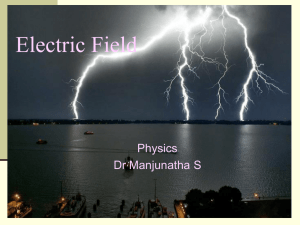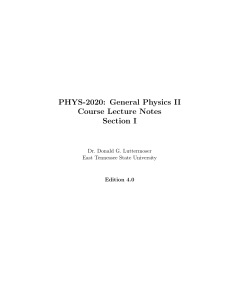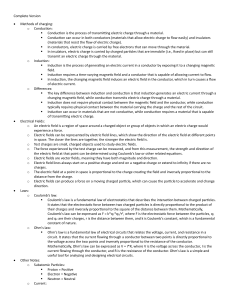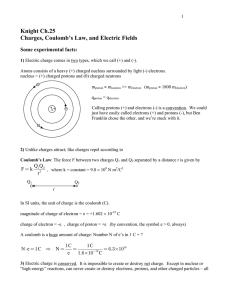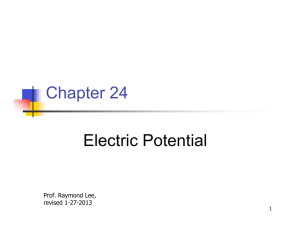electricity - Madison Public Schools
advertisement
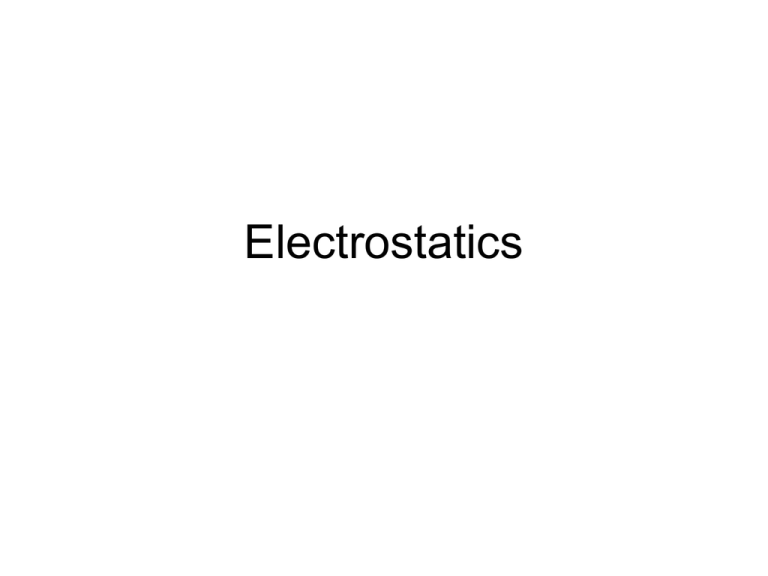
Electrostatics History • The word electricity comes from the Greek elektron which means “amber”. • The “amber effect” is what we call static electricity. Charge Concepts • Opposite charges attract, like charges repel. • Law of Conservation of Charge: – The net amount of electric charge produced in any process is zero. • Symbol: q, Q • Unit: C, Coulomb Elementary Particles Particle Charge, (C) Mass, (kg) electron -1.6x10-19 9.109x10-31 proton neutron +1.6x10-19 0 1.673x10-27 1.675x10-27 • If an object has a… + charge it has less electrons than normal - charge it has more electrons than normal qtotal # electrons 1.6 x1019 Ions and Polarity • If an atom loses or gains valence electrons to become + or - , that atom is now called an ion. • If a molecule, such as H2O, has a net positive charge on one side and negative charge on the other it is said to be polar Types of materials 1. 2. 3. 4. Conductor: a material that transfers charge easily (ex. Metals). Insulator: a material that does not transfer charge easily (ex. Nonmetals) Semiconductors: somewhere between 1 & 2 (ex. Silicon, carbon, germanium). Superconductors: some metals become perfect conductors below certain temperatures Ways to Charge • By Conduction: contact occurs between charged object and neutral object. • Result: two objects with same charge • By induction: no contact occurs between charged object and neutral object. » Result: two objects with opposite charge • By friction: materials are rubbed together. Conduction Induction Polarization Lightning Becomes very “negative” Becomes very “positive” Electric Force AKA: Coulomb’s Law Using a torsion balance, Coulomb found that: the electric force between two charges is proportional to the product of the two charges and inversely proportional to the square of the distance between the charges. Electric Force q1q2 F E kc 2 r • q charge, C • r distance between charges, m • FE Electric Force, N VECTOR (so direction matters) • kc coulomb constant, 8.99x109Nm2/C2 Electric Field • Charged objects create an electric field • An electric field is a region where a charged object can be detected ELECTRIC FIELD LINES PROPERTY 1 E-field lines start (leave) on positive charges. E-field lines end (enter) on negative charges. ELECTRIC FIELD LINES q 2q PROPERTY 2 The number of electric field lines is proportional to the magnitude of the charge. The bigger the magnitude of the electric charge the more the amount of E-field lines. ELECTRIC FIELD LINES PROPERTY 3 E-Field lines will NOT cross each other Electric Field The electric force is a field force, it applies force without touching (like the gravitational force) In the region around a charged object, an Electric Field is said to exist Electric Field Rules for Drawing Electric Field Lines 1. The lines must originate on a positive charge (or infinity) and end on a negative charge (or infinity). 2. The number of lines drawn leaving a positive charge or approaching a negative charge is proportional to the magnitude of the charge. 3. No two field lines can cross each other. 4. The line must be perpendicular to the surface of the charge Ex 21.58 p 831: Signs & Why; E smallest, why ELECTRIC FIELD MAPPING • Go to: http://www.cco.caltech.edu/~phys1/java/ph ys1/EField/EField.html • TO PLACE CHARGE ON SCREEN – Set charge magnitude and sign with slider. Click on screen. DO NOT NEED TO PRESS “GO” Electric Field FE E q0 • • • • • • becomes q E kc 2 r E electric field strength, N/C VECTOR q0 + test charge, C q charge producing field, C r distance between charges, m FE Electric Force, N VECTOR kc coulomb constant, 8.99x109Nm2/C2 Conductors in Electrostatic Equilibrium 1. The electric field is zero everywhere inside a conductor. 2. Any excess charge on an isolated conductor resides entirely on the outside surface of the conductor. 3. The electric field just outside the charged conductor is perpendicular to the conductor’s surface. 4. On an irregularly shaped conductor, charge tends to accumulate where the radius of curvature is the smallest, i.e. AT SHARP POINTS.

